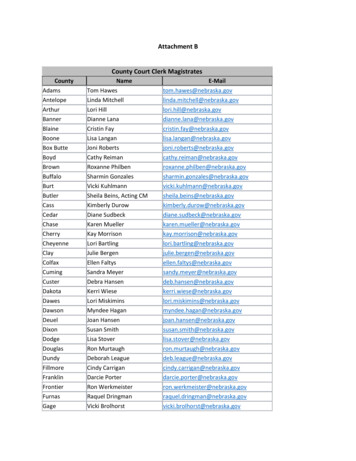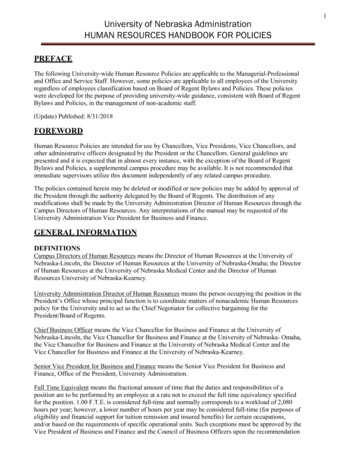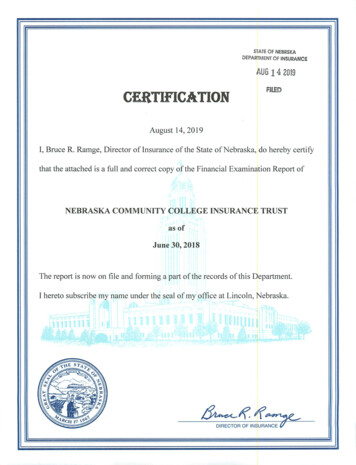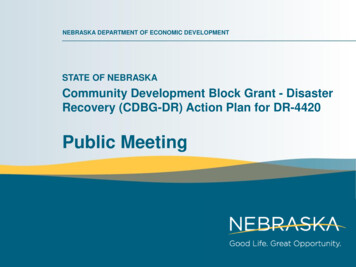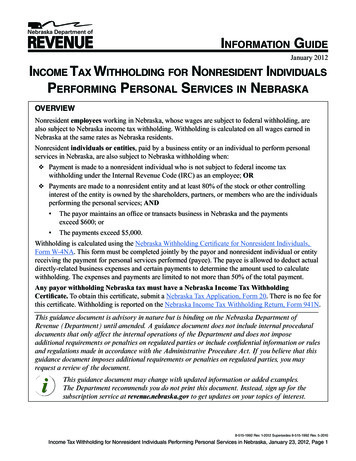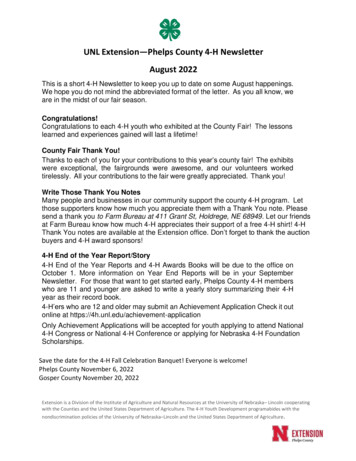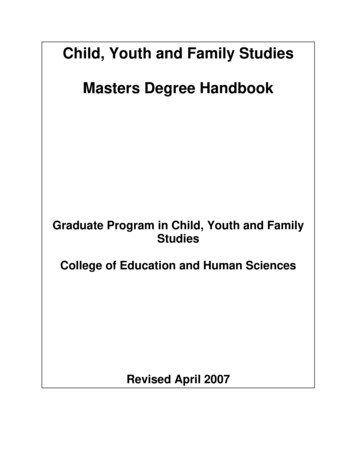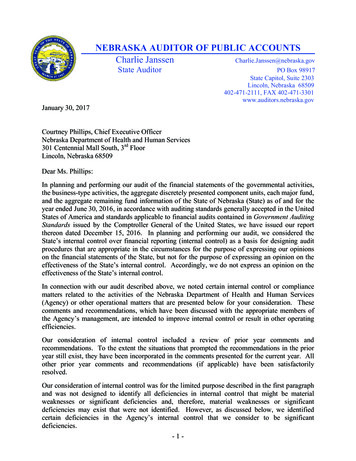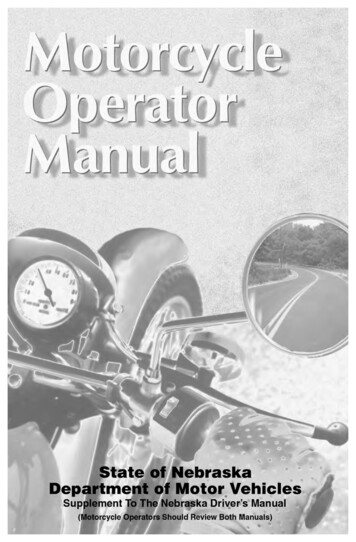
Transcription
STATEOFNEBRASKAOFFICEPete RickettsOF THEGOVERNORP.O. Box 94848 Lincoln, Nebraska 68509-4848Phone: (402) 471-2244 pete.ricketts@nebraska.govGovernorDear Fellow Drivers:Thank you for taking the time to review the Nebraska Motorcycle Manual.The information in this booklet is designed to help you study for the motorcyclewritten and driving tests. I know that you will find the manual useful. Themanual is also available via the Department of Motor Vehicle's website atwww.dmv.nebraska.gov.By reviewing the information in this manual, you will increase your chancesof passing the motorcycle test. You may also learn more about driving safelyon our roads. These days, Nebraskans are driving more vehicles, more miles.This increased traffic generally equates to higher crash rates. By being informedand by following the laws and rules of the road, you can reduce the likelihoodthat you will be involved in a crash.I wish you safe travels as you drive the many beautiful roads and highwaysof Nebraska. I also urge you to review the information in this manual fromtime to time for the safety of all who share our roads.Sincerely,Pete RickettsGovernorAn Equal Opportunity Employer
AGENERAL INFORMATIONPlease review the Nebraska Driver’s Manual in conjunctionwith this manual. It contains important information regardingproof of citizenship/identification, address verification and licensingrequirements that have not been duplicated here. This informationis also available on the Department of Motor Vehicles’ website at:www.dmv.nebraska.gov.The DMV sends renewal notice postcards to individuals 30 daysprior to the expiration of their current license or state identificationcard. To expedite the renewal process, please present this postcard toDriver Licensing Staff at the time of renewal. You will also need topresent a completed data form to Driver Licensing Staff which can befound in the centerfold of this manual.A ”Z” restriction will be placed on the license when a motorscooter or 3 wheeled motorcycle is used during the drive test. Otherrestrictions as determined by Driver Licensing Staff may also be placedon the license.The written motorcycle test (if required) must be passed before themotorcycle skills test is administered. Please check the DMV website orcontact your local Driver Licensing Office to find out when motorcycleskills tests are administered and if an appointment is needed.Motorcycle skills testing will not be administered during inclementweather or if Driver Licensing Staff determine the safety of the rideror examiner is at risk.NOTE: A moped is defined as a bicycle with fully operative pedalsfor propulsion by human power, an automatic transmission and amotor not exceeding 50 ccs that produces no more than two brakehorsepower at a maximum design speed of no more than 30 miles perhour. A Class O (car) license is required to operate a moped on publicroadways.
B MOTORCYCLE LAWSA motorcycle as defined by Nebraska law is a motor vehicle havinga seat or saddle for the use of the driver and designed to travel on notmore than three wheels in contact with the ground, but excluding atractor. All motorcycles and moped operators and passengers arerequired to wear a protective helmet that has been manufacturedto meet the standards of the U.S. Department of Transportation.Anyone in violation of the helmet law will be guilty of a trafficinfraction and fined fifty dollars. (For more information onapproved helmets, contact the Department of Motor Vehicles.) A list of protective helmets that comply with Federal MotorVehicle Safety Standard (FMVSS) 18 can be found by accessingthe following website: .pdf Any person who operates a motorcycle shall ride only upon apermanent and regular seat, and shall not carry any passengerunless it is designed to carry more than one person. Any person shall ride upon a motorcycle only while sitting astridethe seat, facing forward. No person shall operate a motorcycle while carrying any package,bundle, or other article which prevents him or her from keepingboth hands on the handlebars. No operator shall carry any person in a position that will interferewith the operation or control of the motorcycle or the vision ofthe operator. The operator of a motorcycle shall not overtake and pass in thesame lane occupied by the vehicle being overtaken. No person shall operate a motorcycle between lanes of traffic orbetween adjacent lines or rows of vehicles. No person who rides upon a motorcycle shall attach himself orthe motorcycle to any other vehicle on a roadway.
C Any motorcycle which carries a passenger, other than in a sidecar or enclosed cab, shall be equipped with footrests for thepassenger. No person shall operate any motorcycle with handlebars morethan fifteen inches above the mounting point of the handlebars.LEGAL REQUIREMENTSMOTORCYCLE LICENSE, PERMIT OR ENDORSEMENT – It is unlawfulto operate a motorcycle on public roadways without a motorcyclelicense, motorcycle permit or motorcycle endorsement. Applicationand testing requirements are outlined in the Nebraska Driver’s Manual.LICENSE PLATES – It is unlawful to operate a motorcycle without itbeing appropriately registered. A motorcycle must be licensed by thestate. License plates and registrations are obtained from the countytreasurer on proof of ownership, proof of insurance and payment ofa fee.LIGHTS – Every motorcycle shall be equipped with at least one andnot more than two head lamps and with a lamp on the rear exhibitinga visible red light, from a distance of at least five hundred feet fromthe rear.It is recommended that a motorcycle head lamp or lamps be on at alltimes when operating a motorcycle on public roadways.BRAKES – There must be a brake on at least one wheel, and it mustbe maintained in good working order at all times.HORN – This should be securely mounted and audible for a distanceof 200 feet.ACCIDENTS – Involvement in an crash on a motorcycle in whichthere is injury or death or damage exceeding 1,500.00 requires thesubmission of a report to the State within ten days. If the crash wasinvestigated by a law enforcement officer, they will submit the crashreport.HIGHWAY USE – No motorcycles, motor-bikes, and motor scootershaving engines of less than 45 cubic centimeters displacement orwhich have a total wheel and tire diameter of less than 14 inches maybe lawfully registered or operated on a public roadway.It is unlawful to operate motorcycles, motor-bikes, and motor scooterswith an engine horsepower rating of 10 or less on the InterstateHighway System.
DNEBRASKA MOTORCYCLE SAFETYThe Nebraska Department of Motor Vehicles (DMV) has adopted as itsbasic motorcycle education course, the Motorcycle Safety Foundationbeginning rider course entitled “MSF: Basic Rider Course (BRC).” Thiscourse provides for a minimum of 18 hours of motorcycle instructionwith a 3 hour e-course, at least 5 hours of classroom instruction andat least 10 hours of actual range time riding motorcycles. The courseintegrates the classroom instruction and the range driving such thatfollowing classroom instruction, the concepts are applied to andpracticed on the range. The basic course includes the following topics: Location of the controls and pre-ride procedures. Balance and control of the motorcycle. Riding skills and evasive maneuvers. Safety equipment and procedures. Effects of alcohol and drugs while operating a motorcycle.Successful completion of any of the courses listed below will allow thegraduate to have the DMV examiner waive both the written and drivetests within 24 months of course completion when application is madeto obtain a license to operate a motorcycle. Course graduates may alsobe eligible for lower insurance rates. Enrollment is limited and courses often fill quickly, so register early. To obtain more information orto register, contact one of the state approved beginning rider courseproviders listed below.Papillion/Bellevue AreaNebraska Motorcycle Safety TrainingBellevue Fire Department Training Site3100 SP Benson Dr.Bellevue, NE 68147Contact: Pam Marek, 402-593-1564Email: pmarek@sarpy.comWebsite: www.sarpy.com/sheriff/safetyprogramHastings Area:Central Community College – Hastings Campus550 S. Technical Blvd.Hastings, NE 68901Contact: Lindsay Buechler, 1-877-222-0780 Ext. 2431 or402-461-2431Email: lindsaybuechler@cccneb.eduWebsite: www.cccneb.edu/Motorcycle
EKearney Area:Nebraska Safety Center – UNK227E West Center Building, UNK CampusKearney, NE 68849Contact: Erin Howard, 308-865-8256 or 1-800-854-7867 Ext. 2Email: howarder@unk.eduWebsite: www.unk.edu/motorcycle/Lincoln Area:Nebraska Safety Council3270 Folkways Blvd., Ste 201Lincoln, NE 68504-1264Contact: Lisa Henning, 402-483-2511 Ext. 109Email: Lhenning@nesafetycouncil.orgWebsite: www.nesafetycouncil.orgLincoln Area:Southeast Community CollegeLincoln Campus Milford Campus8800 O St.600 State St.Lincoln, NE 68520Milford, NE 68405Contact: Diane Vesley-Robb, 402-437-2710Email: dvesleyrobb@southeast.eduWebsite: www.southeast.edu/Lincoln Area:H&H Frontier LLC DBA Frontier Harley Davidson205 NW 40th St.Lincoln, NE 68528Contact: Tara Clark, 402-466-9100Email: tarac@frontierhd.comWebsite: www.frontierhd.comNorfolk Area:Northeast Community College801 E. Benjamin Ave.Norfolk, NE 68702-0469Contact: Donna Andrews, 402-844-7216Email: donnaa@northeast.eduWebsite: www.northeast.edu/
FNorth Platte Area:Mid-Plains Community College11 Halligan Dr.North Platte, NE 69101Contact: Jeff Smeltzer, 308-535-3687Email: Smeltzerj@mpcc.eduWebsite: www.mpcc.eduNortheast Nebraska Area:Western Iowa Technical Community CollegeBox 5199Sioux City, IA 51102-5199Contact: Mark Combs, 712-274-6449Email: mark.combs@witcc.eduWebsite: www.witcc.com/(Course information is only available by a phone call)Omaha Area:Dillon Brothers Harley-Davidson3838 N. HWS Cleveland Blvd.Omaha, NE 68116Contact: Mark Howie, 402-289-5556Email: mhowie@dillonharley.comWebsite: www.dillonharley.com/
CONTENTS CONTENTS NEBRASKA SPECIFICSGeneral Information AMotorcycle Laws BLegal Requirements CBEING IN SHAPE TO RIDEWhy This Information IsImportant 40Alcohol and Other Drugs inMotorcycle Operation 40NEBRASKA MOTORCYCLESAFETY . D-FAlcohol in the Body 40THE RIDER ANDTHE MOTORCYCLEMinimize the Risks 42 3PREPARING TO RIDEAlcohol and the Law 41Step in to Protect Friends 42Cannabis andMotorcycle Operation 43Wear the Right Gear 4Fatigue 43Know Your Motorcycle 6EARNING YOUR LICENSEOR ENDORSEMENT .44Know Your Responsibilities 9RIDE WITHIN YOUR ABILITIESBasic Vehicle Control 10THREE-WHEEL SUPPLEMENTKeeping Your Distance 13Supplementary Informationfor Three-Wheel Motorcycles 46SEE 17Know Your Vehicle 46Intersections 19Basic Vehicle Control 48Increasing Conspicuity 22Carrying Passengers and Cargo 51Crash Avoidance 25HAND SIGNALS 52Handling Dangerous Surfaces 28Mechanical Problems 30Animals 32Flying Objects 33Getting Off the Road 33Carrying Passengersand Cargo 33Group Riding 36T-CLOCS PRE-RIDE CHECKLIST 54
THERIDER AND THE MOTORCYCLE3RIDING ENVIRONMENTMotorcycling is a unique experience.Compared to a car, you don’t sit in amotorcycle, you become its upper half.Not as a passive driver, but as an activerider leaning into a string of smoothcorners, playing along with the rhythmof the road; shifting, accelerating, andbraking with precision. Whether youride to and from work or prefer thecamaraderie of a group ride on theweekend, motorcycling engages all yoursenses and creates an exhilarating senseof freedom.Along with that freedom comesresponsibility. All states require someform of license or endorsement todemonstrate you possess a minimumlevel of skill and knowledge. This bookletand other motorcycle publications canhelp prepare you to be successful. Youmight also consider taking a formalhands-on training course, even if yourstate doesn’t require that you completeone. You’ll learn how to improve yourriding skills and mental strategies, so youcan be a safer, more alert rider and enjoyriding that much more.The diagram above illustrates thecomplex environment that awaits you,and supports the concept that, as theMotorcycle Safety Foundation says, “Saferiding depends as much on the mentalskills of awareness and judgment as itdoes on the physical skill of maneuveringthe machine.”Successfully operating a motorcycle isa much more involved task than drivinga car. Motorcycling requires strength,coordination, and balance, as well asa heightened sense of awareness andposition amidst other roadway users. Amotorcycle is more responsive than acar, but is also more sensitive to outsideforces, like irregular road surfaces orcrosswinds. A motorcycle is also lessvisible than a car due to its narrowerprofile, and offers far less protection byexposing its rider to other traffic and theelements. All these risks can be managedthrough training and education.
4 PREPARING TO RIDEPREPARING TO RIDE 4What you do before you begin a ride goes a long way toward riding safelyand effectively. Before any ride, a safety-minded rider makes a point to:1. Wear the right gear.2. Become familiar with the motorcycle.3. Check the motorcycle parts and controls.WEAR THE RIGHT GEARWhen you ride, your gear is “right”if it protects you. In any crash, you havea far better chance of avoiding seriousinjury if you wear: A DOT-compliant helmet. Face or eye protection. Protective clothing.Helmet UseCrashes can occur — particularlyamong untrained, beginning riders.And one out of every five motorcyclecrashes results in head or neck injuries.Head injuries are just as severe as neckinjuries — and far more common. Crashanalyses show that head and neckinjuries account for a majority of seriousand fatal injuries to motorcyclists.Research also shows that, with fewexceptions, head and neck injuries arereduced by properly wearing a qualityhelmet.Some riders choose not to wear ahelmet. But, here are some facts toconsider: A DOT-compliant helmet lets yousee as far to the sides as necessary.Studies show that a helmet does notkeep a rider from spotting danger. Most crashes happen on short trips(less than five miles long), just a fewminutes after starting out. Most riders are riding slower than30 mph when a crash occurs. Atthese speeds, helmets can cut boththe number and the severity of headand neck injuries by half.No matter what the speed, helmetedriders are three times more likely tosurvive head injuries than those notwearing helmets at the time of thecrash. The single most important thingyou can do to improve your chances ifyou crash is to wear a securely fastened,quality helmet.Helmet SelectionRecommended are two primary typesof helmets, providing two differentlevels of coverage: three-quarter and fullface.Whichever style you choose, you canget the most protection by making surethat the helmet: Is designed to meet U.S. Department of Transportation (DOT)and state standards. Helmets witha label from the Snell MemorialFoundation also give you anassurance of quality. Fits snugly, all the way around. Has no obvious defects such ascracks, loose padding or frayedstraps.Whatever helmet you decide on, keepit securely fastened on your head whenyou ride. Otherwise, if you are involvedin a crash, it might fly off your head
5 CONTENTS 5before it gets a chance toprotect you.HELMETSEye and FaceProtectionA plastic impact-resistantfaceshield can help protectyour whole face in a crash.It also protects you fromwind, dust, dirt, rain, insectsand pebbles thrown upfrom cars ahead. Theseproblems are distractingand can be painful. If youhave to deal with them, youcan’t devote your full attention to theroad.Goggles protect your eyes, thoughthey won’t protect the rest of your facelike a faceshield does. A windshieldattached to the motorcycle is not asubstitute for a faceshield or goggles.Most windshields will not protectyour eyes from the wind. Neither willeyeglasses or sunglasses. Glasses won’tkeep your eyes from watering, andthey might blow off when you turnyour head while riding, or in windyconditions.To be effective, eye or faceshieldprotection must: Be free of scratches. Be resistant to penetration. Give a clear view to either side. Fasten securely, so it does not blowoff. Permit air to pass through, to reducefogging. Permit enough room for eyeglassesor sunglasses, if needed.Tinted eye protection should notbe worn when little outside light isavailable.ClothingThe right clothing protects you. It alsoprovides comfort as well as protectionfrom heat, cold, debris and hot andmoving parts of the motorcycle. It canalso make you more visible to others. Jacket and pants should cover armsand legs completely. They should fitsnugly enough to keep from flappingin the wind, yet loosely enough toallow you to move freely. Leatheroffers the most protection. Sturdysynthetic material provides a lot ofprotection as well. Wear a jacketeven in warm weather to preventdehydration. Many are designedto protect without getting youoverheated, even on summer days.Some riders choose jackets and pantswith “body armor” inserts in criticalbody areas for additional protection. Boots or shoes should be high andsturdy enough to cover your anklesand give them support. Soles shouldbe made of hard, durable, slipresistant material. Keep heels short sothey do not catch on rough surfaces.Tuck in laces so they won’t catch onyour motorcycle. Gloves allow a better grip and help
6 PREPARING TO RIDEprotect your hands. Your glovesshould be made of leather or similardurable material. Hearing protection reduces noisewhile allowing you to hear importantsounds such as car horns or sirens.Long term exposure to engine andwind noise can cause permanenthearing damage even if you wear afull face helmet. Whether you choosedisposable foam plugs or reusablecustom molded devices, be sureyou adhere to state laws regardinghearing protection.In cold or wet weather, your clothesshould keep you warm and dry, aswell as protect you from injury. Youcannot control a motorcycle well ifyou are numb. Riding for long periodsin cold weather can cause severe chilland fatigue. A winter jacket shouldresist wind and fit snugly at the neck,wrists and waist. Good-quality rainsuitsdesigned for motorcycle riding resisttearing apart or ballooning up at highspeeds.CLOTHINGKNOW YOURMOTORCYCLEThere are plenty of things on thehighway that can cause you trouble.Your motorcycle should not be oneof them. To make sure that yourmotorcycle won’t let you down: Start with the right motorcyclefor you. It should fit you well. Read the owner’s manual. Be familiar with the controls. Check the motorcycle beforeevery ride. Keep it in safe riding conditionbetween rides. Avoid add-ons and modificationsthat make it more difficult to handle.The Right Motorcycle For YouFirst, make sure your motorcycle isright for you. It should “fit” you. Yourfeet should reach the ground whileyou are seated on the motorcycle, andthe controls should be easy to operate.Smaller motorcycles are usually easierfor beginners to operate.At a minimum, your street-legalmotorcycle should have: Headlight, taillight and brakelight.TEST YOURSELF1A plastic shatter-resistant face shield:A. Is not necessary if you have awindshield.B. Only protects your eyes.C. Helps protect your whole face.D. Does not protect your face as well asgoggles.Answer - page 45
7 Front and rear brakes.of experience on their motorcycle. Turn signals.Get Familiar with theMotorcycle Controls Horn. Two mirrors.Borrowing and LendingBorrowers and lenders of motorcycles,beware. Crashes are more likely to occuramong beginning riders — especiallyin the first months of riding. Riding anunfamiliar motorcycle adds risk. If youborrow a motorcycle, get familiar withit away from traffic. And if you lendyour motorcycle to friends, make surethey are licensed and know how to ridebefore allowing them out into traffic.No matter how experienced youmay be, ride extra carefully on anymotorcycle that’s new or unfamiliarto you. More than half of all crashesinvolve riders with less than five monthsMake sure you are completely familiarwith the motorcycle before you takeit out on the street. Be sure to reviewthe owner’s manual. This is particularlyimportant if you are riding a borrowedmotorcycle.If you are going to use an unfamiliarmotorcycle: Check it out thoroughly. Find out where everything is, particularly the turn signals, horn,headlight switch, fuel-supply valveand engine cut-off switch. Find andoperate these items without havingto look for them. Know the controls. Work thethrottle, clutch lever, brakes,MOTORCYCLE CONTROLS
8 PREPARING TO RIDEand shifter a few times beforeyou start riding. Be very familiarwith the friction zone for manualtransmissions. Ride very cautiously and be awareof surroundings. Accelerate gently,take turns more slowly and leaveextra room for stopping.Check Your MotorcycleA motorcycle needs more frequentattention than a car. A minor technicalfailure on a car is seldom more than aninconvenience for the driver. The samefailure on a motorcycle may result in acrash or having to leave your motorcycleparked on the side of the road. Ifanything’s wrong with your motorcycle,you’ll want to find out about it beforeyou get in traffic.The primary source of informationabout how a motorcycle should beinspected and maintained is its owner’smanual. Be sure to absorb all of itsimportant information. A motorcyclewill continue to ride like new if it ismaintained and routine inspectionsbecome part of its maintenance.A pre-ride inspection only takesa few minutes and should be donebefore every ride to prevent problems.It’s quick and easy to check the criticalcomponents and it should be as routineand automatic as checking the weatherforecast before heading out for the day.A convenient reminder developed byMSF is T-CLOCSSM. There is a T-CLOCS“tear-out” sheet at the back of thismanual for you to keep. A T-CLOCSinspection should be conducted beforeevery ride, and includes checks of:T — Tires and Wheels Check tire inflation pressure,treadwear and general condition ofsidewalls and tread surface. Try the front and rear brake levers oneat a time. Make sure each feels firmand holds the motorcycle when fullyapplied.C — Controls Make sure the clutch and throttleoperate smoothly. The throttle shouldsnap back to fully closed whenreleased. The clutch should feel tightand should operate smoothly. Try the horn. Make sure it works.L — Lights and Electrics Check both headlight and taillight.Test the switch to make sure bothhigh and low beams work. Turn on both right and left handturn signals. Make sure all lights areworking properly. Try both brakes and make sure eachone turns on the brake light. Clean and adjust mirrors beforestarting. It’s difficult to ride with onehand while you try to adjust a mirror.Adjust each mirror so you can seethe lane behind and the lane nextto you. When properly adjusted, amirror may show the edge of yourarm or shoulder – but it’s the roadbehind you and to the side that areimportant.O — Oil and Other Fluids Check engine oil and transmissionfluid levels. Check the brake hydraulic fluid andcoolant level, if equipped, weekly. Be sure your fuel valve is open, ifequipped, before starting out. Withthe fuel valve closed, your motorcyclemay start with only the fuel that isstill in the lines, but will stall once thelines are empty. Look underneath the motorcycle forsigns of an oil or fuel leak.
C — Chassis Check the front suspension. Ensurethere is no binding. The rear shocksand springs should move smoothly. If there is a chain or belt, adjustaccording to the manufacturer’sspecifications, and check thesprockets for wear or damage.S — Stands Ensure the side stand operatessmoothly and that the spring holds ittightly in the up position. If equipped,the center stand should also be heldfirmly against the frame whenever themotorcycle is moving.Additionally, regular maintenancesuch as tune-ups and oil changes areimportant. Wear and tear is normalwith use; routine maintenance willhelp prevent costly breakdowns.The schedule for regular upkeepfor motorcycle parts and controls iscontained in the motorcycle’s owner’smanual.KNOW YOURRESPONSIBILITIES“Accident” implies an unforeseenevent that occurs without fault ornegligence. In traffic, that is not thecase. In fact, most people involved ina crash should probably claim someresponsibility for what takes place.Consider a situation where someonedecides to drive through an intersectionon a yellow light turning red. Yourlight turns green. You pull into theintersection without checking forpossible traffic. That is all it takes for thetwo of you to crash. It was the driver’sresponsibility to stop, and it was yourresponsibility to look before moving out.Someone else might be the first to startthe chain of events leading to a crash,9but it doesn’t leave any of us free of ourresponsibility to reduce risk.As a rider you can’t be sure that otheroperators will see you or yield the rightof way. To lessen your chances of acrash occurring: Be visible — wear proper clothing,use your headlight, ride in the bestlane position to see and be seen. Communicate your intentions —use the proper signals, brake lightand lane position. Maintain an adequate spacecushion — when following, beingfollowed, lane sharing, passing andbeing passed. Search your path of travel 12seconds ahead. Identify and separate hazards. Be prepared to act — remain alertand know how to carry out propercrash-avoidance skills, like firmbraking or swerving.Blame doesn’t matter when someoneis injured in a crash. The ability to rideaware, make critical decisions and carrythem out separates responsible ridersfrom the rest. Remember, it is up to youto keep from being the cause of, or anunprepared participant in, any crash.TEST YOURSELF2More than half of all crashes:A. Occur at speeds greater than 35mph.B. Happen at night.C. Are caused by worn tires.D. Involve riders who have less thanfive months of experience on theirmotorcycles.Answer - page 45
10 RIDE WITHIN YOUR ABILITIESReading this manual does not teach you the physicals skills to controldirection, speed or balance. That’s something you can learn only throughpractice, preferably in a formal course of instruction like an MSF RiderCourse.But control begins with knowing your abilities and riding within them, alongwith knowing and obeying the rules of the road.BASIC VEHICLE CONTROLBody PositionTo control a motorcycle well: Posture — Position yourselfcomfortably so you are able tooperate all the controls and steereffectively. This helps you interact wellwith your motorcycle and allows youto react quickly to hazards. Seat — Sit far enough forward sothat arms are slightly bent when youhold the handgrips. Bending yourarms permits you to press on thehandlebars without having to reachtoo far. Hands — Hold the handgripsfirmly to keep your grip over roughsurfaces. Start with your right wristflat. This will help you keep fromaccidentally using too much throttle.Also, adjust the handlebars so yourhands are even with or below yourHOLDING HANDGRIPSelbows. This permits you to use theproper muscles for proper steering. Knees — Keep your knees againstthe gas tank to help you keep yourbalance as the motorcycle turns. Feet — Keep your feet firmly on thefootrests to maintain balance. Don’tdrag your feet. If your foot catcheson something, you could be injuredand it could affect your control ofthe motorcycle. Keep your feet nearthe controls so you can get to themeasily if needed. Also, don’t let yourtoes point downward — they mayget caught between the road and thefootrests.Shifting GearsThere is more to shifting gears thansimply getting the motorcycle to pickup speed smoothly. Learning to use thegears when downshifting, turning orstarting on hills is equally important forsafe motorcycle operation.The gearshift lever is located in frontof the left footrest and is operated bythe left foot. To shift “up” to a highergear, position your foot under the shiftlever and lift and release. To downshift,press the shift lever down and release.The shift lever changes one geareach time it is lifted or pressed down.Whenever the lever is released, springloading returns it to center, where themechanism resets for the next shift upor down. A typical gear pattern is 1-N2-3-4-5. The N is for neutral, which isselected by either a “half lift” from 1stgear or a “half press” from 2nd gear.
Most motorcycles have five gears, butsome have four or six gears.As your motorcycle increasesspeed, you will need to shift up to ahigher gear. Shift up well before theengine RPM reaches its maximumrecommended speed. As a general rule,shift up soon enough to avoid overrevving the engine, but not so soon tocause the engine to lug.SHIFTING GEARS11slightly while smoothly easing out theclutch lever can help the engine comeup to speed more quickly and make thedownshift smoother. Shifting t
Lincoln Area: Nebraska Safety Council 3270 Folkways Blvd., Ste 201 Lincoln, NE 68504-1264 Contact: Lisa Henning, 402-483-2511 Ext. 109 Email: Lhenning@nesafetycouncil.org Website: www.nesafetycouncil.org Lincoln Area: Southeast Community College Lincoln Campus Milford Campus 8800 O St. 600 State St. Lincoln, NE 68520 Milford, NE 68405
